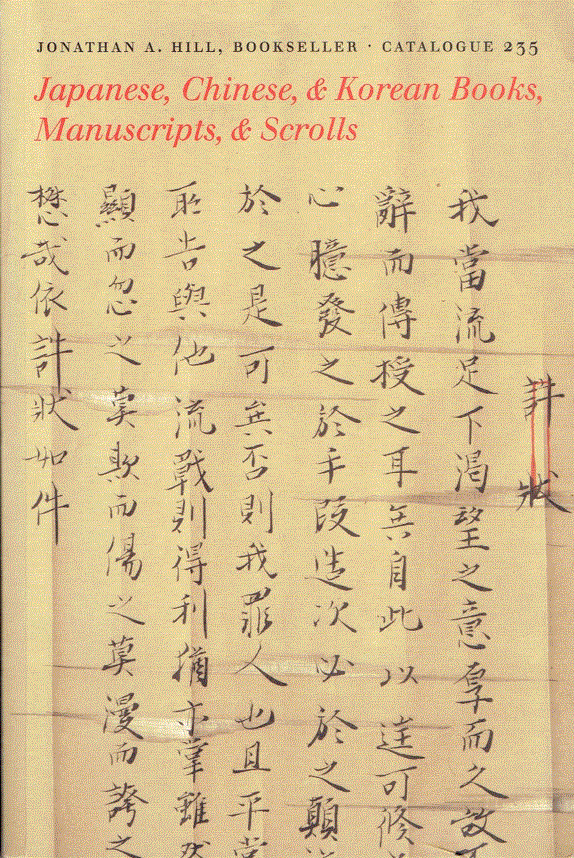Japanese, Chinese and Korean Works from Jonathan A. Hill Bookseller
- by Michael Stillman

Japanese, Chinese and Korean Works from Jonathan A. Hill Bookseller
Jonathan A. Hill Bookseller has released a new catalogue of Japanese, Chinese, & Korean Books, Manuscripts, & Scrolls. These are older works with a variety of subjects covered. Many are illustrated, with illustrations worthy of being called art. These are primarily original drawings, found on manuscripts, documents and scrolls. One of the more common subjects is medicine, both human and equine. Several items refer to the struggles in opening Japan to the outside world and trade, primarily from the standpoint of the Japanese who wished to be left alone. Considering what the world has become, that sentiment is certainly understandable. Here are a few selections from this latest catalogue of the Far East.
If you go back several centuries, Chinese medicine was more advanced than bloodletting and prayer often featured in the West. The problem was that it didn't advance very much when new experiments and discoveries started exploding in the West. Tradition held sway over experimentation. Item 65 is Shinkyu Bassui (translated) Essentials of Acupuncture and Moxibustion. The author is unknown. Most people are familiar with acupuncture. Moxibustion involves placing heat sources to particular body parts, or to acupuncture needles. Some of these hundreds of years old treatments still have benefits, though obviously they pale in importance to later developments such as antibiotics and vaccines. This book was published in five parts in two volumes in 1674. It explains where to place needles, twist them, how to remove a broken needle, and how to hit a needle with a mallet. Ouch! There are also explanations of where to place moxa cones used for heating the skin. Priced at $9,500.
Next is Kaitai hatsumo (Explanation of human anatomy), by Soshu Mitani, published in 1813. Hill describes this as “the first Japanese exposition of the whole system of human anatomy based upon original observation.” That observation was based on three dissections performed in Kyoto in 1783, 1798, and 1802. That's not much frequency of dissections, but those were banned in much of the West as well. Mitani also made use of numerous other sources, including both traditional Chinese and Western literature, Dutch in particular. The Japanese traded with the Dutch and Dutch East India Company for centuries while other nations were locked out, so their books were the primary source of Western knowledge in Japan at the time. Evidently, the author or publisher was aware that Chinese medicine was not keeping up with the West as an inserted advertisement for the book (not present here) says the it is based on “some new Dutch theories and moreover some dissections of real dead body to make it sure. And it has become clear that Dutch theories are right and the traditional Japanese and Chinese theories which [have been] with us for 3,000 years [are] quite wrong.” The book contains “very well executed” color plate drawings of various internal organs and structures. Item 46. $30,000.
Most people in the West associate the invention of movable type with Johannes Gutenberg. Certainly his invention is one of the most important developments for human knowledge in history. However, movable type was invented in China centuries earlier. Gutenberg had a major advantage in that he could make his words from just 26 letters. Chinese uses characters rather than letters, making each word a totally separate piece, and there are thousands of them. The early Chinese characters were carved on wooden blocks, which also had a disadvantage in that they wore out quickly from repeated use, yet some printers continued to find them better than other available options many centuries later. Item 9 is a collection of 1,470 pieces of movable Chinese wooden type, created circa 1862-1874. They come in three cases with larger and smaller font sizes. By this time, wooden type was only being used for printing small runs of books, 100 copies or fewer, or forbidden books. Item 9. $7,500.
Item 5 is a Japanese Black Ship scroll, from 1853-4. The Black Ships were what the Japanese called ships visiting from western nations, and more often than not, they were not welcome. This was particularly true as this was the time American Commodore Matthew Perry made his uninvited visit, his naval power forcing Japanese leaders to open the nation to foreign trade. Hearing of this, Russia also sent ships to Japan at this time to secure their share of trade. The scroll begins with some information about America, as the Japanese knew very little, and follows with details about Perry's squadron, the names of his ships, their size, number of crewmen and cannons. It then goes on to cover local defense forces, number of troops and equipment. It contains physical descriptions of Perry and other American officers, lists numbers of foot soldiers and sailors and ranks. It is filled with illustrations of the American troops, ships, and shows the reception hall in which Japanese officials met the Americans. There is much more about the American mission and the Russian one as well. The scroll was formed from 35 joined paper sheets. $29,500.
Now we go from practical and scientific to art and imagination. Item 35 is Cho senshu, (one thousand butterflies), by Yukiyoshi Kamisaka, published in 1904. It consists of 25 double-page plates of colored butterflies. They come in two accordion-style volumes. This is not a scientific representation of actual butterfly species but rather a flight of fantasy based on the shape of butterflies. The patterns and colors are from Kamisaka's imagination. $7,500.
Jonathan A. Hill Bookseller may be reached at 917-294-2678 or jonathan@jonathanahill.com. The website is www.jonathanahill.com.